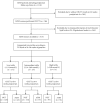Elevated Midtrimester Triglycerides as a Biomarker for Postpartum Hyperglycemia in Gestational Diabetes
- PMID: 32377519
- PMCID: PMC7196153
- DOI: 10.1155/2020/3950652
Elevated Midtrimester Triglycerides as a Biomarker for Postpartum Hyperglycemia in Gestational Diabetes
Abstract
Background: Whether elevated triglyceride (TG) levels during pregnancy were a biomarker for postpartum abnormal glucose metabolism (AGM) in women with previous gestational diabetes mellitus (GDM) remained unknown. The aim of this study was to investigate the association between TG levels during the second trimester and postpartum AGM in GDM women.
Methods: This was a retrospective cohort study including 513 GDM women. A 75 g oral glucose tolerance test (OGTT) was performed, and lipid levels were determined during pregnancy and the postpartum period. GDM patients were categorized into tertiles according to their TG levels at 24-28 weeks of gestation (TG < 2.14 mmol/L, TG: 2.14-2.89 mmol/L, and TG > 2.89 mmol/L). A logistic regression model was used to calculate the odds ratios (ORs) and 95% confidence intervals (CIs).
Results: During pregnancy, women in the high TG tertile showed higher HbA1c levels (5.47 ± 0.58% versus 5.28 ± 0.49%, p = 0.006), higher total cholesterol (TC) levels (5.85 ± 1.23 mmol/L versus 5.15 ± 0.97 mmol/L, p = 0.026), and higher HOMA-IR (2.36 (1.62-3.45) versus 1.49 (0.97-2.33), p < 0.001) than the participants in the low TG tertile. After delivery, the prevalence rates of AGM based on above tertiles of TG levels during pregnancy were 26.90%, 33.33%, and 43.27%, respectively (p = 0.006). High TG tertile during the second trimester was associated with the presence of postpartum AGM (adjusted OR: 2.001, 95% CI: 1.054-3.800, p = 0.034).
Conclusions: The elevated midtrimester TG levels were not only accompanied by higher glucose and lipid levels and more severe insulin resistance at the time of the measurement but were a biomarker for postpartum AGM as well.
Copyright © 2020 Mengyu Lai et al.
Conflict of interest statement
The authors declare that there are no conflicts of interest regarding the publication of this paper.
Figures


References
-
- Daly B., Toulis K. A., Thomas N., et al. Increased risk of ischemic heart disease, hypertension, and type 2 diabetes in women with previous gestational diabetes mellitus, a target group in general practice for preventive interventions: a population-based cohort study. PLoS Medicine. 2018;15(1) doi: 10.1371/journal.pmed.1002488. - DOI - PMC - PubMed
-
- Grunnet L. G., Hansen S., Hjort L., et al. Adiposity, dysmetabolic traits, and earlier onset of female puberty in adolescent offspring of women with gestational diabetes mellitus: a clinical study within the Danish National Birth Cohort. Diabetes Care. 2017;40(12):1746–1755. doi: 10.2337/dc17-0514. - DOI - PMC - PubMed
MeSH terms
Substances
LinkOut - more resources
Full Text Sources
Medical
Miscellaneous

